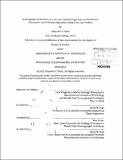| dc.contributor.advisor | Heidi M. Nepf. | en_US |
| dc.contributor.author | Ortiz, Alejandra C | en_US |
| dc.contributor.other | Woods Hole Oceanographic Institution. | en_US |
| dc.date.accessioned | 2012-10-26T18:06:19Z | |
| dc.date.available | 2012-10-26T18:06:19Z | |
| dc.date.copyright | 2012 | en_US |
| dc.date.issued | 2012 | en_US |
| dc.identifier.uri | http://hdl.handle.net/1912/5280 | en_US |
| dc.identifier.uri | http://hdl.handle.net/1721.1/74403 | |
| dc.description | Thesis (S.M.)--Joint Program in Marine Geology and Geophysics (Massachusetts Institute of Technology, Dept. of Civil and Environmental Engineering; and the Woods Hole Oceanographic Institution), 2012. | en_US |
| dc.description | Cataloged from PDF version of thesis. | en_US |
| dc.description | Includes bibliographical references (p. 77-79). | en_US |
| dc.description.abstract | This study describes the spatial distribution of sediment deposition in the wake of a circular patch of model vegetation and the effect of the patch on turbulence and mean flow. Two difference types pf vegetation were used along with two different stem densities totaling four different case studies. The spatial location of enhanced deposition correlated with the steady wake zone, which has length, L1. The steady wake zone only occurred downstream of the rigid emergent patches of vegetation and was not seen downstream of the flexible submerged patches of vegetation. The enhanced deposition occurred when both turbulence and mean velocity was below the upstream, initial values. The enhanced deposition occurred when the mean velocity was less than or equal to half of the initial velocity. For the four cases studied, theses parameters of low velocity and low turbulence were primarily met within the steady wake region immediately downstram of the two rigid emergent patches of vegetation. In all four cases, large coherent structures are created in the flow due to the patch. Lateral vortices are formed downstream of the patch in a von-Karman vortex street that meets at the center of the flow a distance, Lw, downstream of the patch. For the flexible submerged cases, streamlines reattach to the bed of the flume a distance, Lv, downstream of the patch. In addition, for the flexible submerged cases, a secondary circulation is generated with flow moving laterally away from the patch at the surface and toward the centerline of the patch at the bed. | en_US |
| dc.description.statementofresponsibility | by Alejandra C. Ortiz. | en_US |
| dc.format.extent | 117 p. | en_US |
| dc.language.iso | eng | en_US |
| dc.publisher | Massachusetts Institute of Technology | en_US |
| dc.rights | M.I.T. theses are protected by
copyright. They may be viewed from this source for any purpose, but
reproduction or distribution in any format is prohibited without written
permission. See provided URL for inquiries about permission. | en_US |
| dc.rights.uri | http://hdl.handle.net/1912/5280 | en_US |
| dc.rights.uri | http://dspace.mit.edu/handle/1721.1/7582 | en_US |
| dc.subject | Joint Program in Marine Geology and Geophysics. | en_US |
| dc.subject | Civil and Environmental Engineering. | en_US |
| dc.subject | Woods Hole Oceanographic Institution. | en_US |
| dc.subject.lcsh | Turbidity currents | en_US |
| dc.subject.lcsh | Aquatic plants | en_US |
| dc.title | Investigation of the effect of a circular patch of vegetation on turbulence generation and sediment deposition using four case studies | en_US |
| dc.type | Thesis | en_US |
| dc.description.degree | S.M. | en_US |
| dc.contributor.department | Joint Program in Marine Geology and Geophysics | en_US |
| dc.contributor.department | Woods Hole Oceanographic Institution | en_US |
| dc.contributor.department | Massachusetts Institute of Technology. Department of Civil and Environmental Engineering | |
| dc.identifier.oclc | 803583885 | en_US |
